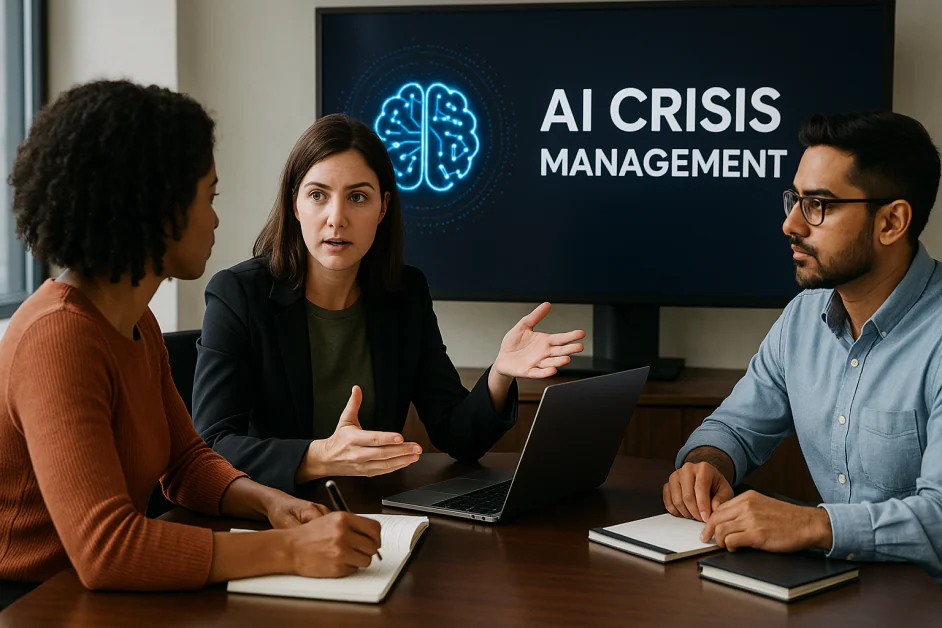Thought Leaders
The AI Crisis Playbook for the Fourth Industrial Revolution

A recent World Economic Forum report predicts that 83 million jobs will be displaced globally by 2027 due to automation and AI, even as 69 million new roles emerge. That’s a net loss of 14 million jobs. Such an immense shift in the workforce will inevitably force every company to either adapt or fall by the wayside.
We’ve entered the Fourth Industrial Revolution, where AI is both the catalyst and the accelerant of change. For corporate leaders, this is not just about technology — it’s about managing the narrative as they lead their teams through the uncertainty of this new era. In this new world where disruption is the norm, the winners will be those who make strategic communication part of their AI integration plan.
The Speed of Disruption
History shows that industrial revolutions punish hesitation. Steam, electricity, computing — each shifted the skills market faster than legacy systems could keep up. The Fourth Industrial Revolution is different in one critical way: AI doesn’t just change what we make or how we sell, it changes how we think about work itself.
And it’s doing it faster than most executives are prepared for. The McKinsey data is blunt: by 2030, tasks currently done by humans could be reduced by up to 30%. That’s not an efficiency gain — that’s a fundamental restructuring event.
I’ve spent more than a decade in the crisis communications industry. At our firm Red Banyan, we help clients either prepare for or react to PR crises – events or situations that threaten their reputations, negatively impact their operations, or undermine stakeholder trust. Typical PR crises range from complaints on social media, to product recalls, data breaches, and negative news media reports. The impending impact of AI is no different than these other PR crises, but it will affect a lot more companies.
Risk Assessment and Reskilling Strategy
As the job displacement clock is ticking, the lag between disruption and retraining becomes an operational risk. Corporate leaders must act quickly to assess their exposure to AI disruptions and ensure they are preparing the workforce accordingly.
According to research by Microsoft, professionals in non-technical roles—especially in marketing, sales, and customer service—stand to benefit significantly from AI if equipped properly. The report found that 70% of workers are eager to offload mundane tasks to AI, but only a fraction have received training. This disconnect presents a massive opportunity: companies that move quickly to bridge the skills gap will outperform those that lag behind.
Here’s how corporate leaders can start assessing their exposure to AI disruptions and create a workforce reskilling strategy:
- Identify critical vulnerabilities — Map every function against its exposure to AI automation. Rank them by urgency.
- Set reskilling deadlines — For example, “Within 90 days, 50% of X team will complete Y training” is a target you can track.
- Integrate human-AI pairing — Teach employees not just to use AI, but to manage it — checking outputs, spotting errors, and improving their prompts.
As you begin assessing your exposure and reskilling needs, make sure to ask yourself these AI Crisis-Readiness Questions:
The 7 AI Crisis-Readiness Questions Every CEO Should Answer
- Which roles in our organization are most vulnerable to AI automation — and have we mapped them?
- If 30% of a department’s tasks were automated tomorrow, what is our 90-day reskilling plan?
- Do we have a pre-approved “AI change comms kit” for employees, customers, and stakeholders?
- Who on our team is empowered to make rapid decisions about AI adoption and workforce adjustments?
- Have our middle managers received AI literacy training and crisis communication coaching?
- What’s our protocol for detecting and countering misinformation about AI changes inside the company?
- If AI implementation failed or caused backlash, who leads our crisis response — and have we rehearsed it?
Internal Communication as a Priority
In crisis work, silence is rarely the correct strategy. The goal is to actively shape your narrative – not let others create it for you. The same applies to AI transitions. Employees aren’t just wondering what’s coming; they’re wondering what their leadership thinks, and what they’re going to do about it.
Your corporate AI comms kit should include:
- Pre-approved talking points explaining the “why,” “when,” and “how” of AI changes.
- An FAQ that addresses hard questions (“Will my role exist in 12 months?”).
- A rapid-response channel so managers can escalate sensitive issues before they turn into PR crises.
Before making any external AI announcement, run an internal readiness drill: if your team can’t explain the change in their own words, you’re not ready to go public.
The AI Change Management
In a crisis, speed and agility are paramount. AI disruption demands the same.
Build an “AI change management team” — a cross-functional group empowered to make quick calls on AI adoption, workforce planning, and comms. Meet weekly or bi-weekly, assess your internal communication and implementation efforts, and adjust plans as needed.
Middle managers are your front line. In my crisis experience, they make or break execution. Give them:
- AI literacy training so they understand both the tools and the strategic rationale.
- An initial pilot program – start by assigning a small AI project that would allow managers to experience the benefits of AI firsthand and build confidence in its capabilities.
- A level of authority to make tactical adjustments without waiting for top-down approvals.
When middle managers can explain the “why” behind AI changes, they become your most effective change agents.
The Real Competitive Advantage
Not every company will survive this transition intact. The ones that do will have treated AI like the live, evolving crisis it is: planning ahead, speaking with candor, and reskilling with urgency.
The technology race is already underway, but the trust race — the one between corporate leadership and their workforce — is just beginning.
Those who win it will not be the companies with the flashiest tools, but the ones with leaders willing to face disruption head-on, speak the hard truths, and act before the alarm bells ring.












